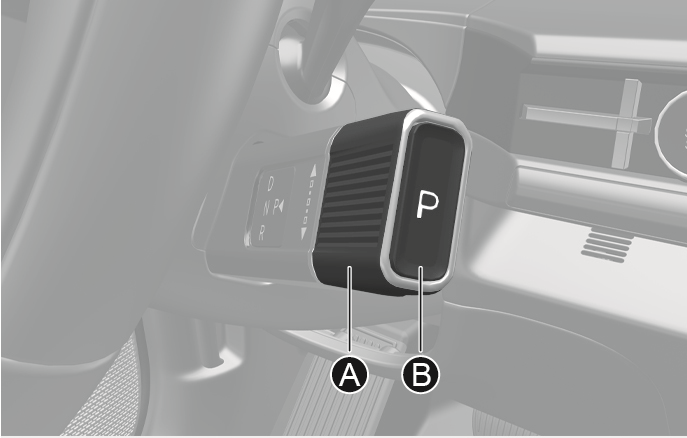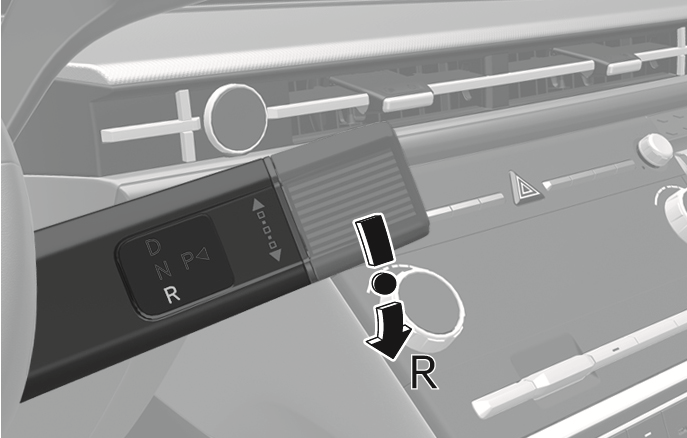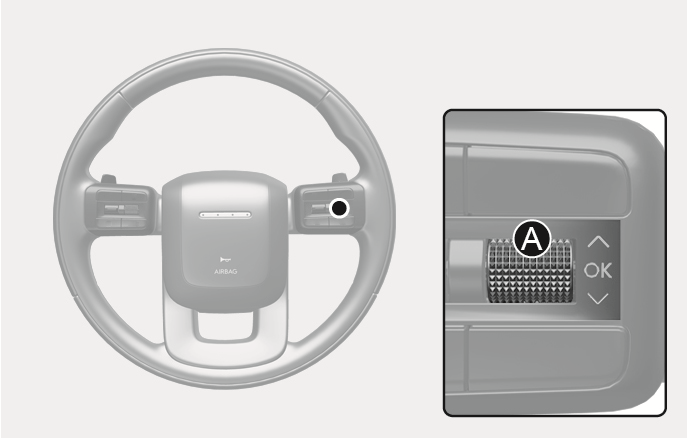Dual Clutch Transmission (Rotary gear shift dial type)

2C_ShiftButtonOverview
- Rotary gear shift dial
- P button
Depress the brake pedal whenever rotating the gear shift dial or shifting to P (Park).
The indicator on the cluster displays the rotary gear shift dial position when the Engine Start/Stop button is in the ON position.
P (Park)

2C_PressPButton
Always come to a complete stop before shifting into P (Park).
To shift the gear to P (Park), press the P button while depressing the brake pedal.
If you turn the engine off in R (Reverse), N (Neutral) or D (Drive), the gear automatically shifts to P (Park).
-
Shifting into P (Park) while the vehicle is in motion may cause you to lose control of the vehicle.
-
After the vehicle has stopped, always make sure the vehicle is in P (Park), apply the parking brake, and turn the engine off.
-
When parking on an incline, shift the gear to P (Park) and apply the parking brake to prevent the vehicle from rolling downhill.
Automatic gear shift to P (Park)
The gear is shifted to P (Park) automatically for safety reasons under the following conditions:
-
When the engine is turned off with the gear in R (Reverse), D (Drive) or N (Neutral).
-
When the driver's door is open with the engine running, the gear in R (Reverse), D (Drive) or N (Neutral) and the vehicle at a standstill.
-
When the driver's door is open with the gear in N (Neutral) and the vehicle is off.
In situations the gear must be in P (Park), always check if the gear is shifted to P (Park) by checking the cluster display.
R (Reverse)

2C_ShiftButtonRPosition
Use this position to drive the vehicle backward.
To shift the gear to R (Reverse), rotate the rotary gear shift dial to R (Reverse) while depressing the brake pedal.
When the vehicle is stopped in the R (Reverse) position, if you open the driver's door, the gear automatically shifts to P (Park).
However, if the vehicle is in motion, the gear may not automatically shift to P (Park) to prevent dual clutch transmission damage.
Always come to a complete stop before shifting into or out of R (Reverse). You may damage the transmission if you shift into R (Reverse) while the vehicle is in motion.
N (Neutral)

2C_ShiftButtonNPosition
The wheels and transmission are not engaged.
To shift the gear to N (Neutral), rotate the rotary gear shift dial to N (Neutral) from R (Reverse) or D (Drive) while depressing the brake pedal.
Always depress the brake pedal when you are shifting from N (Neutral) to another gear.
If you turn the engine off in N (Neutral), the gear automatically shifts to P (Park).
However, if you need to stay in N (Neutral) with the engine off, refer to the following "To stay in N (Neutral) when vehicle is OFF" section.
The engine can be started with the gear in N (Neutral), but for you safety, be sure to start the engine with the gear in P (Park).
To stay in N (Neutral) when vehicle is OFF

2C_SteeringWheelOkButton
If you want to stay in N (Neutral) after the engine is OFF (in the ACC state), do the following.
-
Turn off Auto Hold and apply the parking brake when the engine is running.
-
Rotate the shift dial to N (Neutral) while depressing the brake pedal.
-
When you take your foot off the brake pedal, the message "Press and hold the OK button on the steering wheel to stay in Neutral" appears on the cluster display.
-
Press and hold the OK button [A] on the steering wheel for more than 1 second.
-
When the message "Neutral will stay engaged when the vehicle is Off" appears on the cluster display, turn the vehicle off while depressing the brake pedal.
If you want to turn off the engine, press the P button while the Engine Start/Stop button is in the ON position.
With the gear in N (Neutral), the Engine Start/Stop button is in the ACC position. In the ACC position, the doors cannot be locked. The battery may discharge if left in the ACC position for a long time.
D (Drive)

2C_ShiftButtonDPosition
This is the normal forward driving position. The transmission automatically shifts to the optimal gear ratio, providing better fuel efficiency and a smoother ride.
To shift the gear to D (Drive), rotate the rotary gear shift dial to D (Drive) while depressing the brake pedal.
For extra power when passing another vehicle or driving uphill, depress the accelerator further until you feel the transmission downshift to a lower gear.
When the vehicle is stopped in the D (Drive) position, if you open the driver's door, the gear automatically shifts to P (Park).
If the vehicle is moving in D (Drive), the gear may not automatically shift to P (Park) to protect the dual clutch transmission damage.
When you start after stopping on a steep incline, even if the gear is in D (Drive), if you do not depress the accelerator or brake pedal, the vehicle may roll backwards, which can cause a collision.
Shift-lock system
For your safety, the dual clutch transmission has a shift-lock system which prevents shifting the transmission from P (Park) into R (Reverse) or D (Drive) unless the brake pedal is depressed.
To shift the transmission from P (Park) into R (Reverse) or D (Drive):
-
Depress and hold the brake pedal.
-
Start the engine or place the Engine Start/Stop button in the ON position.
-
Depress the brake pedal and put the gear in R (Reverse) or D (Drive).